
WINGS Tour: Ecuador, The South 2023
28 October - 14 November, 2023
The Crew: Dennis, Emily, Janet, Mark, John, a different John, Phil, one more Jon (bird guy), and Jorge (el chofer)
With hardly a straight road or flat ground in sight, we drove for about 4000km covering a vast swath of southern Ecuador starting and ending in Guayaquil. We stopped and birded at the great reserves and parks from the mangroves of the Pacific coast to the rainforests of the remote Cordillera del Condor, and the arid thornscrub and dry-forests of the Tumbesian desert of the southwest, plus various mountaintops, valleys, rain shadows, wetlands, random roadsides, and the grounds and bird feeders of fine eco-lodges. We even snuck into Peru for a couple of hours and ticked a few birds there. Covering the many diverse habitats, it’s no wonder that the bird list went well above 500 species, and the highlights included Jocotoco Antpitta, Gray Tinamou, Gray-breasted Mountain-Toucan, Orange-throated Tanager, Long-wattled Umbrellabird, and Blue-throated Hillstar among other rare, endemic, difficult, and some really flashy-looking birds.
The day began by getting out of Guayaquil before it woke up and traffic clogged the roads. But, we didn’t have to go too far. In the tropical deciduous forest on the edge of the extant mangroves lies Manglares-Churute National Park, and our first stop of the day. The special Jet Antbird took some work, but other things like bright Black-faced Dacnis and great Great Antshrike and a Peruvian Pygmy-Owl just came to us. We moved from forest to wetland and saw a literal flock of hundreds of swarming Snail Kites. They were everywhere, and after the swarm they settled into the trees in such a way that branches bent and there was no room for anything else. Their chattering was complemented by the tootling and honking of a half a dozen Horned Screamers perched in nearby bushes. We then drove a bit and stopped in a little fishing town where we got close looks at both Fulvous and Black-bellied Whistling-Ducks, hundreds of herons, egrets, and ibis, Roseate Spoonbills, and Wood Storks. Landbirds there were good, too, with a Baird’s Flycatcher that materialized in front of us, and a flock of Chestnut-throated Seedeaters out in the weeds. Though the goal of the day was to get to Umbrellabird Lodge, the birding along the way on our first day out was just splendid.


Our second day of birding was our first day of “big hits.” The morning was just generally busy with tanager flocks, mobs of hummingbirds, and some fly-by El Oro Parakeets. The hummingbirds included some crowd favorites like Violet-tailed Sylph and Green Thorntail, and the tanagers were the likes of Golden Tanager, Beryl-spangled Tanager, and Bay-headed Tanager. We also found a few Club-winged Manakins at their business. But, the big hit came late in the afternoon on a rainy walk into the jungle where we encountered a couple of the bizarre and spectacular Long-wattled Umbrellabirds. Only in a place like Ecuador with every tiny ecological niche filled could something with a foot-long retractable wattle fly breezily through the forest. It was amazing.

The next day saw another transition, this time from the wet western rainforest to the dry forest of southern Loja. The morning started in the rain and fog of Reserva Buenaventura. We mostly stuck around under the roof and watched hummingbirds and the light flocks that drifted by through the trees. Among the throngs of hummingbirds, we counted only a single Brown Violetear and followed it about its business. Below, near the ground, were Gray-and-gold Warblers, a feisty Buff-rumped Warbler, and a Bay Wren that was pretty enough for a thicket skulker to have been worth the work. Leaving the rainforest, we passed over some ridges into a very different landscape wherein squat, gnarled ceibo trees poked up above the acacia thornscrub and the ground was dusty and crinkled with dry leaves. We made a couple of quick stops before getting to the lodge, and were rewarded with a pair of White-headed Brushfinches. Settling into the lodge we ate dinner to the sounds of Pale-browed Tinamous whistling the forest around us.
We spent a full day birding the dry forest. The fruit feeders outside of the lodge were piled high with Rufous-headed Chachalacas, and there were a lot of Blue Ground-Doves around, though they were mostly quietly stationed in the trees. Our walks through the forest encountered pulses of birds that included dry forest specialties like Blackish-headed Spinetail, Ecuadorian Piculet, and charming little Scarlet-backed Woodpeckers. Some other highlights included a gaggle of White-winged Brushfinches and a formidable array of raptors like King Vulture, Gray-backed Hawk, Short-tailed Hawk, Zone-tailed Hawk, Harris’s Hawk, and Savanna Hawk. Even in this hot, dry weather the birds were on.
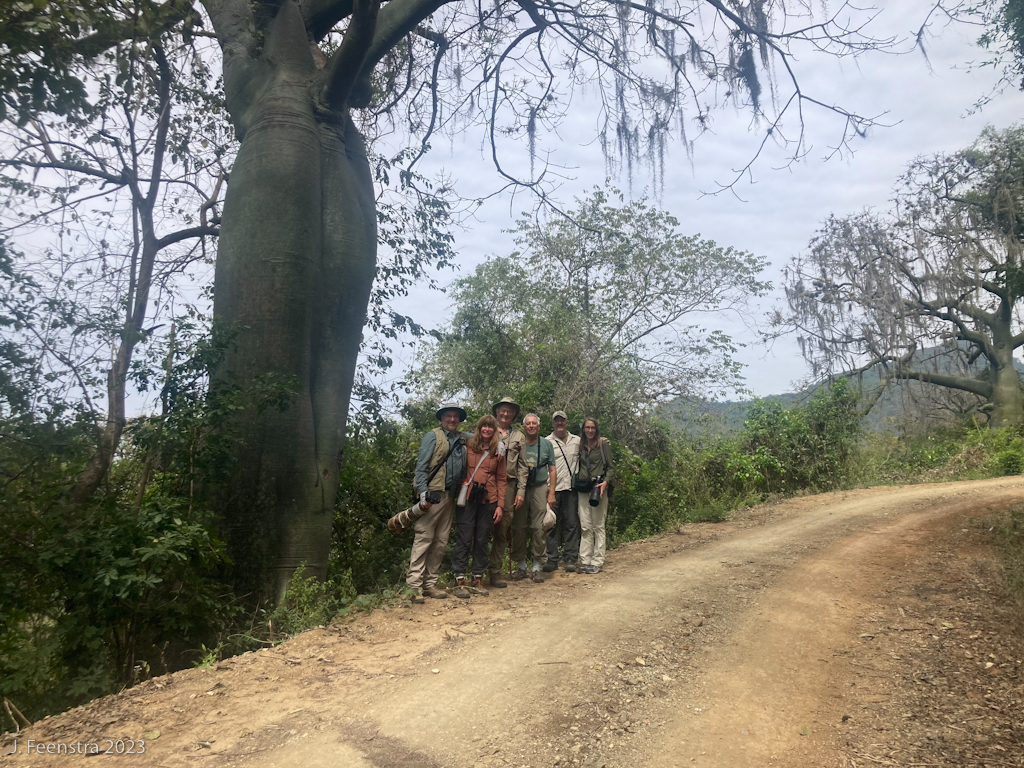

The desert adventure continued with both high elevations and low. We started in some mossy forest at nearly 2000 meters elevation. There was a big, cool Ecuadorian Trogon, while swift Rufous-necked Foliage-Gleaners were darting about, and Blackish Tapaculos were being difficult. Hummingbirds were fancy with showy Rainbow Starfrontlets dominating the scene. In even more arid country we had nice looks at the truly elegant Elegant Crescentchest and the more (much more) subtle Marañon Tyrannulets did their subtle things. From the desert wilds we arrived at our big city high-rise hotel in urban Loja for a fine dinner and a bottle of wine.
The mountains treated us well today. We started in the upper elevations of Podocarpus National Park and found big, cool things like Turquoise Jays, Hooded Mountain-Tanagers, and a very cooperative Masked Trogon. We also did well with little things, including sublime Golden-crowned Tanager, a scarce Red-hooded Tanager, and a shockingly well-seen Chusquea Tapaculo. There were also hummingbirds – three species of sunangel, striking Collared Incas, and a few Mountain Velvetbreast to name the highlights. The only complaints were that the sunangels sat in the shade, the redstarts weren’t red, and the thistletail’s tail was missing and therefore not very thistle-y. We arrived in the afternoon to watch Bearded Guans in front of our lodge before the night in Reserva Tapichalaca.

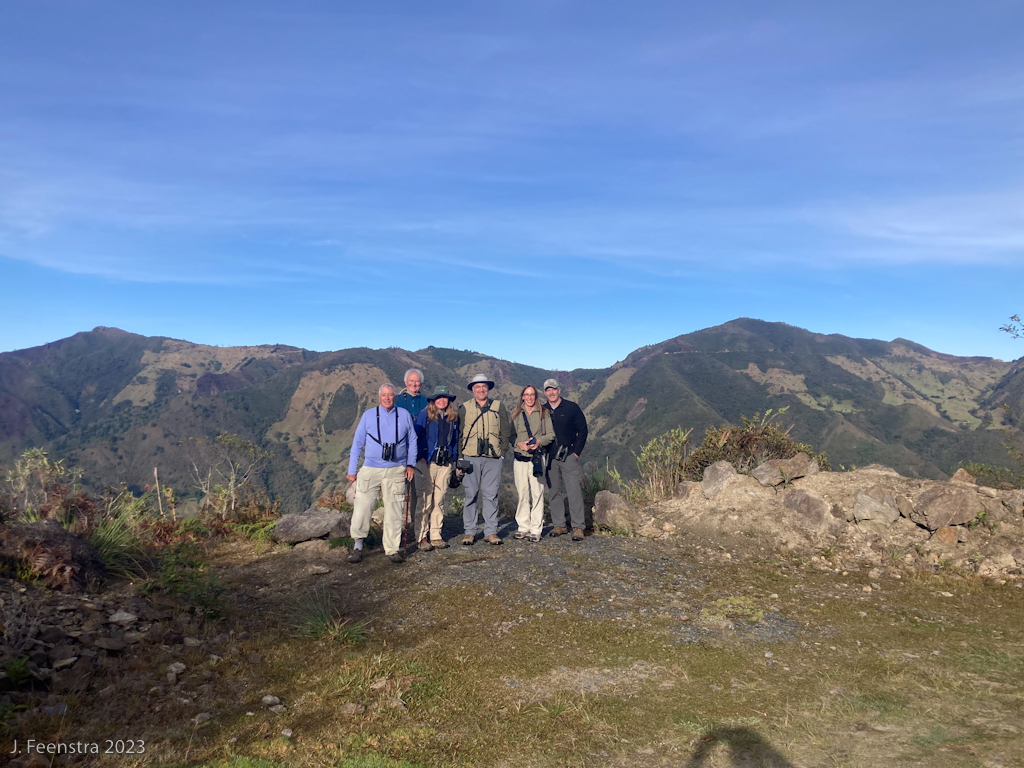


Though we visit a number of Jocotoco Foundation reserves on this tour, there is only one in which the Jocotoco Antpitta, flagship species of the reserve system and conservation foundation, can be found. And, find it we did. The Big Daddy himself. He even chased off a Chestnut-naped (lowly peasant) Antpitta to assert his confidence at total coolness. Otherwise, it was also a day of good things. Gray-breasted Mountain-Toucan, Grass-green Tanager, Rufous-crowned Tody-Flycatcher, and Glossy-black Thrush were other cloud forest goodies. In the afternoon we followed the highway to lower elevations in the Marañon watershed and found some lowland things like our first tanager explosion: Paradise Tanager, Golden-eared Tanager, Blue-necked Tanager, Silvery Tanager, Blue-gray Tanager, Palm Tanager, and Black-faced Tanager with Black-faced and Blue Dacnises on the side.






Then we had a rainy day, but it fortunately fell on a day with a lot of driving and not as much birding. We, with too much optimism, tried some high elevation birding, but the howling wind, blowing fog, and general unpleasantness scared us off. We managed fine looks at the rainbow beard of a Rainbow-bearded Thornbill, but the further birds were lost in the fog. We dried out at lunch, but it didn’t last long. We watched some White-capped Dippers and a female Torrent Duck in the whitewater, but rain scared us off again. Fortunately, we then weren’t far from the porch and feeders of Copalinga Lodge. We finished out our day in the dumping rain watching Violet-fronted Brilliants shine in the dim light, an Orange-billed Sparrow scratch around, and hot coffee in our mugs.



The next day we spent in the lower elevations of Podocarpus National Park along the Rio Bombuscaro outside of the town of Zamora. We began with a Fasciated Tiger-Heron on a rock at a small stream crossing. Within the forest, a totally different mix of birds awaited us, with Paradise, Spotted, Blue-necked, Bay-headed Tanagers about. We saw a Coppery-chested Jacamar bringing food to its nest. And, we connected with a pair of Foothill Elaenias, a bird new to science only about twenty years ago. Back at the lodge, we saw some more tanagers and hummingbirds before heading into the forest for the special show of a Gray Tinamou that waits for some corn every evening. It’s a primordial-looking bird, a window back into the age of dinosaurs (but also kind of looks like a watermelon on legs).




Going down in elevation to the low Amazonian foothills in the Rio Nangartiza valley we encountered another new group of birds. We had some classics like Channel-billed Toucans, and some equally exotic looking things like Gilded Barbet and Yellow-tufted Woodpecker. And, sometimes, even when seeing a lot of birds, there is time to notice the little things, the little stories that are part of observing wildlife. We watched a pair of Golden-faced Tyrannulets dive-bombing a Ruddy Pigeon. We couldn’t find a nest, but those two little flycatchers were very upset and the pigeon seemed to show no effect. Similarly inexplicable, we watched a Violaceous Jay fly a long way over the jungle in pursuit of a Greater Yellow-headed Vulture. Perhaps both were instances of mistaken identity. The Blue-black Grassquit doing his funny jump while he sang, however, is just what those things do.
Our full day in the Nangaritza Valley was a whirlwind of birds. It was hard to remember at dinner what we had been seeing that morning! Tanagers were fancy with Opal-rumped, Flame-crested, and Magpie Tanagers among dozens of individuals of a dozens other species. We had great looks at a few Purplish Jacamars and some new toucans: Golden-collared Toucanet, Ivory-billed Aracari, and Chestnut-eared Aracari. The Golden-collared Toucanet was a standout in that it perched in a dead tree and called for a while, jerking its body and bill around as it released its guttural squawk. We even got into the deep dark woods to winkle out some interior forest birds and ended up seeing White-browed Antbird, Zimmer’s Antbird, and Foothill Stipplethroat.



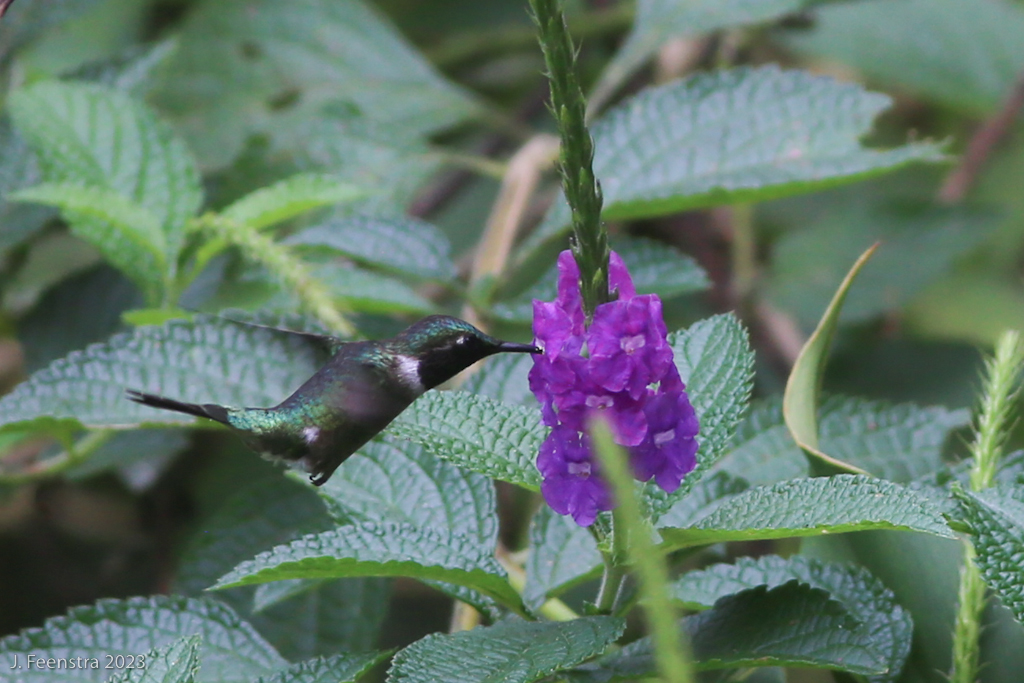
Before leaving the lowlands this day we had a couple of outstanding missions. Though the Orange-throated Tanager has become harder to find, our work was rewarded and we found one singing loudly from a tree over the road. It’s not just a special species with a tiny range, it’s also spectacular. Our second mission was a stealthy invasion of Peru to tick a few secret birds. Perhaps unbeknownst to anyone in Peru, the road in this remote part of Ecuador crosses the border for about 300m and gives us a chance to up our international birding game. We got there and found some birds. Our favorites were a pair of Yellow-bellied Dacnises, including a female building a nest on a tree fern. Another favorite were a pair of Spot-backed Antbirds, one of the best-looking antbirds and pleasantly well-seen by everyone.

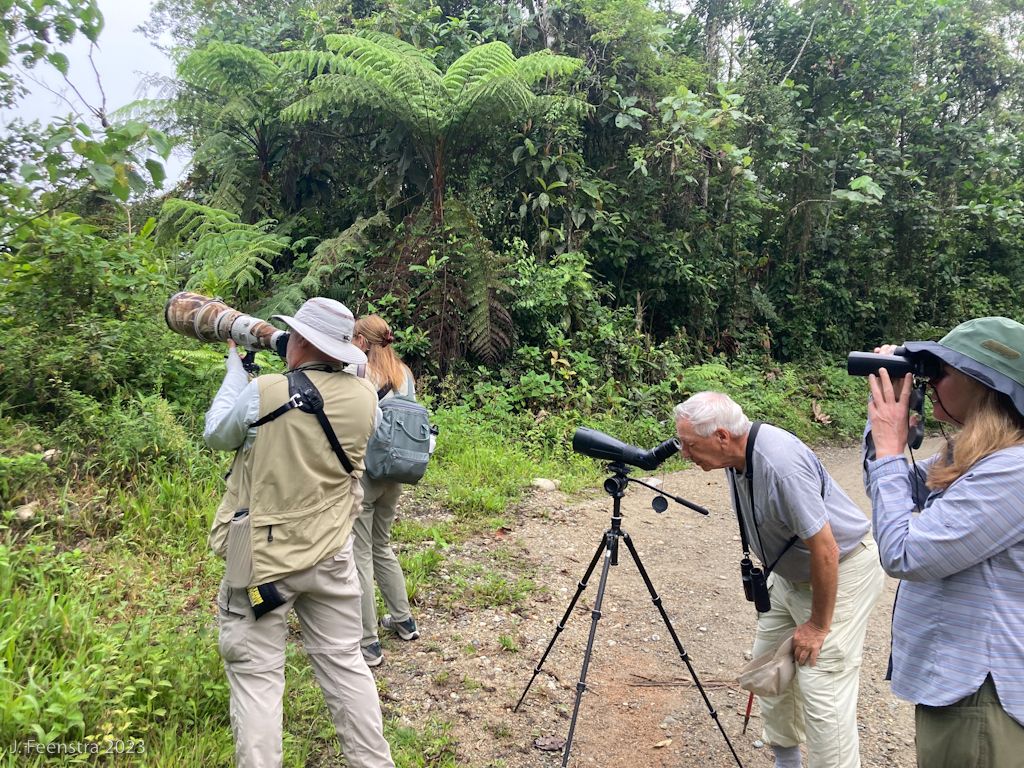
With warm thoughts in our head we made the ascent from the low humid forest to the highlands. We started in some high elevation “temperate” forest with some spectacular tanager flocks. There were dozens of Masked Flowerpiercers moving about and nearly as many Lacrimose Mountain Tanagers. At one point we had a scope view with Scarlet-bellied Mountain Tanager, Lacrimose Mountain Tanager, Golden Grosbeak, and Yellow-breasted Brushfinch. And another view with Superciliaried Hemispingus with Blue-and-black Tanagers. It was cold and rainy, but when the birding is good, it doesn’t seem to matter. We climbed further uphill from there to the remote paramó mountaintop of Cerro de Arcos. There we saw a few of the recently discovered Blue-throated Hillstars.
Our morning for hillstar part 2 was successful, but the brisk mountain weather was perhaps a bit on the extra brisk side with howling wind and blowing fog. The hillstar showed, though, and so did the other cool high mountain things. We saw a few Tawny Antpittas including one that ran across the road in front of us, and a few Paramo Pipits doing pipit things. At the lodge a Great Sapphirewing was being great while a Shining Sunbeam (one among many around) sat on a nest up in the rafters of the building. Before our descent, some of us got to see an Andean Condor drift overhead. The descent was a radical change – from the cool lush paramo to barren arid scrubland, reminiscent of the Badlands of South Dakota. There are birds there, too, though, and we stopped for a Short-tailed Field Tyrant and a trio of Burrowing Owls before reaching the bottom and our next destination.
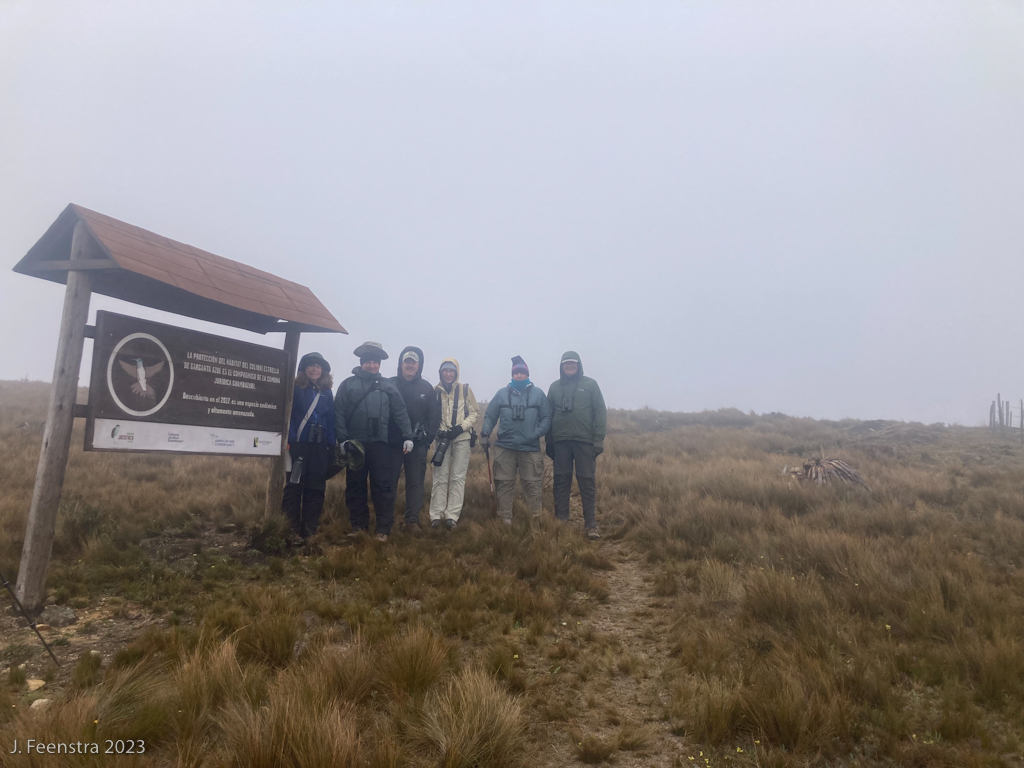




On an endemic roll, we began the next day at the Yunguilla Reserve wherein lies the core range of the critically endangered Pale-headed Brushfinch, a species once thought extinct. It’s not the most striking of birds, but it is special and another conservation success story as the tourists come from all over to a small reserve outside of a small town to see it. However, as usual, it’s not the only bird there! The reserve also hosted a couple of very accommodating Chestnut-crowned Antpittas and an equally accommodating Slaty-backed Nightingale-Thrush (eating white bread, of course). Leaving there we ascended to our next lodge of the tour on the edge of El Cajas National Park above the city of Cuenca. With a little poking around we located a Violet-throated Metaltail, a hummingbird species nearly endemic to the park. Andean Gulls wheeled about and we enjoyed a tasty dinner (and a birthday party) way up in the mountains.






Our last day of birding continued in the mountains in the brisk, high elevation air of El Cajas. We began in the lower part of the park (still at about 10,000 feet) and walked the edge of an alpine lake. A Virginia Rail wandering around out on the mudflat was an unexpected surprise among the other normal lake birds like Andean Teal, Yellow-billed Pintail, and Slate-colored Coot. We then moved to a higher part of the park, above 13,000 feet, for different things in the above-tree-line paramó. We had great looks at both male and female Ecuadorian Hillstar, especially nice after our recent encounters a few days ago with their new cousin. We also saw multiple Tawny Antpittas, a pleasure knowing how difficult their forest relatives are to see. Our final highlight of the mountains was a positively glowing Tit-like Dacnis, its saturated blue complemented by the look of texture its feathers gave it. All with the backdrop of rugged Andean peaks in all directions. These scenic heights were the last birding of this tour, and we dropped down through two distinct bands of fog and landed back down at sea level and the highway to Guayaquil. We wrapped up in the same hotel restaurant in which we started, five hundred and something birds later, and a whole lot of memorable travel.

This narrative (without the photos) will also be posted on the WINGS website.
The list and eBird trip report (where participants will be posting their photos) is HERE.
All the non-bird things that I photographed during the tour are in iNaturalist HERE.